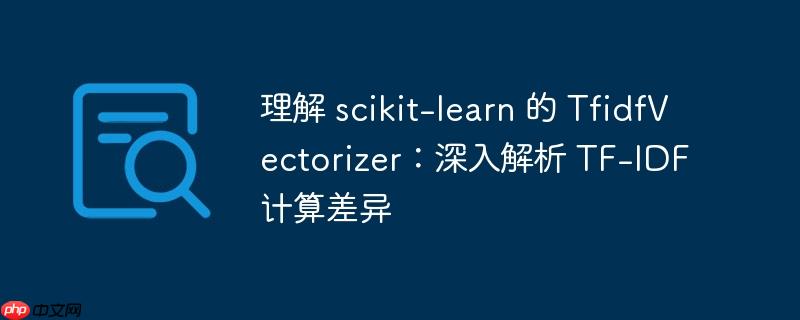
本文旨在深入剖析 scikit-learn 库中 TfidfVectorizer 的工作原理,重点解释其 TF-IDF 计算方式与传统公式的差异。通过对比手动计算和 TfidfVectorizer 的结果,揭示其内部 IDF 计算公式的细节,帮助读者更好地理解和使用该工具,避免在实际应用中产生误解。
TF-IDF (Term Frequency-Inverse Document Frequency) 是一种常用的文本特征提取方法,用于衡量一个词语对于一个文档集合或语料库中的文档的重要性。scikit-learn 库提供了 TfidfVectorizer 类,可以方便地进行 TF-IDF 的计算。然而,在实际使用中,可能会发现 TfidfVectorizer 的计算结果与手动计算的结果存在差异。本文将深入探讨这种差异的根源,并解释 TfidfVectorizer 的内部实现。
TF-IDF 的基本概念
TF-IDF 的计算公式通常为:
TF-IDF = TF * IDF
其中,TF (Term Frequency) 指的是词语在文档中出现的频率。 IDF (Inverse Document Frequency) 指的是逆文档频率,衡量词语的普遍重要性。
IDF 的计算方式
IDF 的计算是造成差异的关键。
手动计算 (非标准 IDF 公式)
通常采用以下公式计算 IDF:
IDF(t) = log(N / DF(t))
其中:
scikit-learn 的 TfidfVectorizer (标准 IDF 公式)
TfidfVectorizer 默认使用以下公式计算 IDF:
IDF(t) = log((1 + N) / (1 + DF(t))) + 1
scikit-learn 这样做有几个原因:
示例分析
考虑以下语料库:
corpus = [
'This is the first document.',
'This document is the second document.',
'And this is the third one.',
'Is this the first document?',
]假设我们要计算词语 "document" 的 TF-IDF 值。
手动计算:
使用 TfidfVectorizer:
from sklearn.feature_extraction.text import TfidfVectorizer
corpus = [
'This is the first document.',
'This document is the second document.',
'And this is the third one.',
'Is this the first document?',
]
vectorizer = TfidfVectorizer(norm=None) # norm=None 禁用归一化
X = vectorizer.fit_transform(corpus)
# 获取词汇表
vocabulary = vectorizer.vocabulary_
print(vocabulary)
# 获取 'document' 的索引
document_index = vocabulary['document']
# 获取第一个文档的 TF-IDF 值
tfidf_vector = X[0].toarray()[0]
tfidf_value = tfidf_vector[document_index]
print(tfidf_value)运行结果会显示一个与手动计算结果不同的值,例如 1.22314355。这是因为 TfidfVectorizer 使用了不同的 IDF 计算公式。
注意事项与总结
通过本文的分析,相信读者能够更深入地理解 scikit-learn 的 TfidfVectorizer 的工作原理,并能够根据实际需求选择合适的参数配置,从而更好地应用 TF-IDF 技术进行文本特征提取。
以上就是理解 scikit-learn 的 TfidfVectorizer:深入解析 TF-IDF 计算差异的详细内容,更多请关注php中文网其它相关文章!

每个人都需要一台速度更快、更稳定的 PC。随着时间的推移,垃圾文件、旧注册表数据和不必要的后台进程会占用资源并降低性能。幸运的是,许多工具可以让 Windows 保持平稳运行。




Copyright 2014-2025 https://www.php.cn/ All Rights Reserved | php.cn | 湘ICP备2023035733号